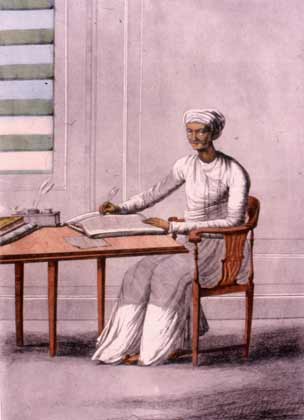Mukherjee, also Mukerjee, Mookerjee, Mukerji, Mukherji, Mukhujje or Mookherjee, is a Bengali Hindu Kulin Brahmin surname originating from the Bengal region of the Indian subcontinent. The traditional Bengali version is Mukhopaddhae, which is sometimes written Mukhopadhyay.
Sen is a native Bengali Hindu surname derived from "Sena", the Sanskrit word for "army".
Das is a common last name in South Asia, among adherents of Hinduism and Sikhism, as well as those who converted to Islam or Christianity. It is a derived from the Sanskrit word Dasa meaning servant, devotee, or votary. "Das" may be inferred to be one who has surrendered to God. The surname is often used by those in the Vaishnav community.

Panchanan Chakravarti was a Bengali Indian revolutionary, one of the creators of the Revolt group after the momentary unification of the Anushilan Samiti and the Jugantar in the 1920s. Friend of the poet Kazi Nazrul Islam, he was a close associate of Subhas Chandra Bose.

Barua is a common Assamese surname. This term is different and not to be confused with the surname used by Buddhists from Bangladesh, Myanmar and Tripura, who also use Barua as surname.
Shyam Sundar Chakravarthy was an Indian revolutionary, independence activist and journalist from Bengal. He was born in Bharenga, Pabna in Bengal Presidency. He belonged to the "Pabna Group" of Bengali revolutionaries along with Abinash Chakravarty and Annada Kaviraj. In 1905 he was the sub-editor of the revolutionary journal Sandhya. In 1906, he joined with Bengali nationalist newspaper Bande Mataram as an assistant to its editor Sri Aurobindo and later became its editor. In 1908, he was deported to Burma. Later he became an adherent of the non violent methods of Indian National Congress and an office bearer of the Swaraj Party. He founded and edited the newspaper "The Servant" in 1920 to promote the Non-cooperation movement.
Dutta, also spelled Datta, is an Indian family name Its variation is Dutt.
Chakravarthy, Chakravarthi, Chakravarti or Chakravarty may refer to:
Dasgupta is a common Bengali Hindu last name or surname that is used by the Bengalis of West Bengal, Assam, Tripura and Bangladesh. The surname is found among the members of the Baidya caste of Bengal.
Pal, alternative form "Paul", is a common surname found in India and Bangladesh. It is traditionally believed that 'Pal' originated from the Sanskrit pala meaning protector or keeper. It is also occasionally found in other countries.
Bhattacharya, Bhattacharyya, and Bhattacharjee are three common spellings of a Bengali Brahmin and Assamese Brahmin surname. In Bengal, Bhattacharjees, together with Banerjees, Chatterjees, Gangulys and Mukherjees, form the Kulin Brahmins.
Sengupta is a Bengali surname found among the Bengalis of West Bengal, Assam, Tripura and Bangladesh. They belong to the Baidya caste of Bengal. The surname is a compound of Sen and Gupta.
Mitra, also called Mittra or Mitro is a Bengali Hindu surname found mostly amongst Bengali Kayastha community in the Bengal region of Indian subcontinent. This surname also has prevalence in Iran and is a popular Persian last name found in America. The surname may have been derived either from the Sanskrit word mitra meaning friend or ally or from the name of an important Indo-Iranian deity in the Vedas and in ancient Iran.
Chakrabarty is a surname. Notable people with the surname include:

The Hymn of Samadhi or A Hymn of Samadhi was a song written by Swami Vivekananda. The song was originally written in Bengali as Nahi surjo, nahi jyoti or Pralay. Later the song was translated into English and was added into "The Complete Works of Swami Vivekananda" as The Hymn of Samadhi.

Bengali Kayastha, is a Bengali Hindu caste originated from the Bengal region of Indian subcontinent, and is one of the main subgroups of the Kayastha community. The historical caste occupation of Kayasthas throughout India has been that of scribes, administrators, ministers and record-keepers; the Kayasthas in Bengal, along with Brahmins and Baidyas, are regarded among the three traditional higher castes that comprise the "upper layer of Hindu society." During the British Raj, the Bhadraloks of Bengal were drawn primarily, but not exclusively, from these three castes, who continue to maintain a collective hegemony in West Bengal.
Acharya is a surname or upādhi also called warrior Brahmins who have much more skills and strategies for victory of a war and so on examples in the history which are mainly found in the South Asian countries of India, Bangladesh and Nepal. In India, it is commonly found among the Vishwabrahmin and Brahmin communities in the Indian states of Gujarat, Maharashtra, Karnataka, Odisha, West Bengal, Tripura, Assam, Tamil Nadu, Kerala, Andhra Pradesh and Telangana
Anirban Chakrabarty is an Indian Bengali film actor. Chakrabarti is known for portraying the character Ekenbabu in a web series. He also played the character Jatayu in a web series directed by Srijit Mukherji. He is popular for his portrayal of the role of "Ekenbabu" in the films The Eken (2022) and The Eken: Ruddhaswas Rajasthan (2023).




